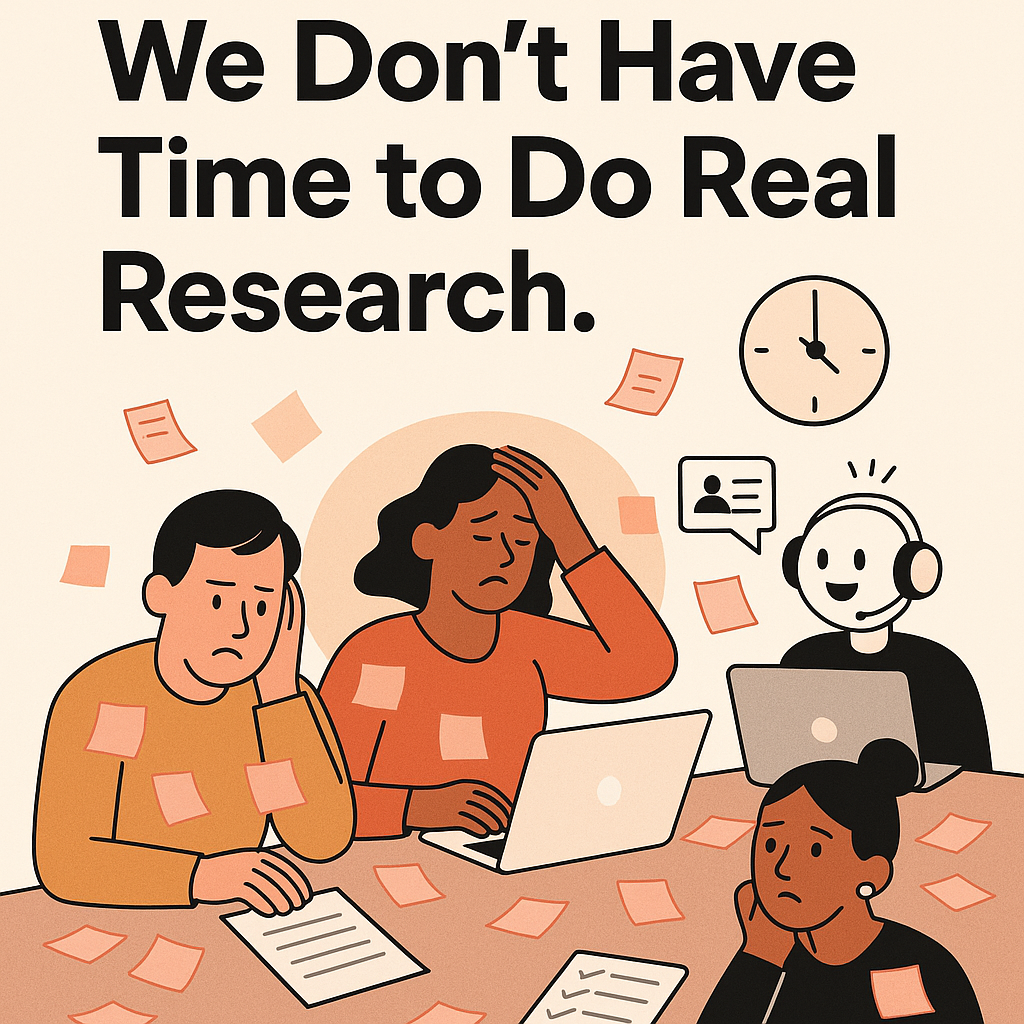
“We don’t have time to do real research.”
If you’ve ever worked on a product team, you’ve heard someone say it — maybe you’ve said it yourself.
There’s always a roadmap, a sprint, or a fire that seems more urgent.
But here’s the irony: teams spend far more time fixing problems they could’ve prevented with a few well-timed conversations.
A few months ago, a SaaS team I know shipped what they proudly called a “power-user dashboard.” Six weeks later, usage was near zero. When they finally talked to customers, they heard:
“Oh — I didn’t even know what that was for.”
One week of interviews could have saved six weeks of rework.
The truth is, research isn’t extra work.
It’s how you save time by being wrong less often.
When teams say they “don’t have time,” what they really mean is that the process feels too heavy.
The real issue isn’t curiosity — it’s friction.
Traditional research means scheduling, moderating, taking notes, analyzing, and reporting — all before the insights make it back into product decisions.
But today’s reality is different.
AI, automation, and async workflows have stripped away that friction.
You can now run meaningful research in hours — without scheduling a single call.
Real research isn’t about big studies or polished decks.
It’s about structured listening that leads to smarter decisions.
Three short async interviews can reveal what a 10-person study used to.
A single open-ended prompt embedded in a product flow can uncover motivations that numbers can’t.
For example:
A PM ran three AI-moderated voice interviews with new users after onboarding. Within a day, the tool summarized a clear insight:
“Most users don’t realize the free plan has limits.”
That one finding — discovered in 24 hours — drove a copy change that improved retention 12% the next week.
That’s what “real research” looks like today: lightweight, continuous, and fast enough to actually guide action.
Skipping research doesn’t skip the work — it just delays it.
You’ll still pay the price later in the form of:
The “we’ll fix it later” tax is steep.
Every hour saved avoiding research risks ten hours of rework down the road.
Metrics can tell you what’s happening, but only people can tell you why.
And that “why” is what keeps teams from wasting cycles.
Skipping research is risky — but doing it wrong can be even worse.
Why? Because bad data leads to confident wrong decisions.
Here are four common traps that mislead teams:
“Wouldn’t it be great if we added X?”
Biased questions confirm assumptions instead of uncovering real needs.
Loud power users ≠ your actual customer base.
Overweighting their opinions leads to misaligned priorities.
“Would you use this?” often gets polite guesses, not honest signals.
Actual past behavior is more reliable than imagined future intent.
Text fields rarely capture nuance — and often miss emotion, hesitation, or tone.
You get surface-level answers, not deep insight.
Bottom line: Flawed research is worse than no research.
Be intentional about how you gather feedback — not just that you do.
Every role has moments when you should pause and listen — even when things are moving fast.
If the data stops making sense — that’s your cue to stop guessing and start listening again.
Gathering high-quality feedback no longer requires scheduling, recruiting, or long surveys.
Here’s how busy teams capture meaningful insights today — without slowing down.
You don’t need a formal session to ask for input.
Add a Calendly link or quick AI feedback prompt right after sign-up, checkout, or onboarding.
Users can share their thoughts on their own time — no back-and-forth needed.
🪄 Turns everyday touchpoints into effortless interviews.
High-open-rate emails — signups, purchases, feature updates — are perfect for short, natural prompts:
“How was your experience with [feature/product] today?”
AI can automatically analyze tone and sentiment across replies.
Low effort, high-quality signal.
Text surveys often feel like homework.
Instead, let users talk.
Offer a short AI-moderated voice interview link after key actions.
They can share thoughts aloud; the AI follows up naturally with relevant questions.
🧠 You get richer, more emotional feedback in less time.
Feedback lives everywhere — surveys, chats, social comments, tickets.
Use Zapier or Make.com to collect it all in one place.
Then send it to an AI qualitative tool (like UserCall) that automatically tags themes and insights.
⚡ You spend less time organizing, more time understanding.
Create a private Slack, Discord, or WhatsApp group of engaged users.
Share new ideas, early features, and get immediate reactions.
It’s continuous, authentic feedback — without scheduling or formal studies.
💬 Turns “research projects” into relationships.
You don’t need a research team.
You need one small rhythm.
That’s it.
No decks. No calendar coordination. Just a consistent habit of listening.
When that rhythm sticks, research stops being a separate activity.
It becomes the way your team learns.
You don’t need more time to do research — you need less friction.
AI and automation now handle the painful parts: recruiting, scheduling, transcribing, tagging, and summarizing.
You focus on what actually matters: understanding users deeply and acting fast.
Every email, chat, and interaction is a chance to listen.
Every KPI change is a signal to ask “why.”
Start small. Automate the rest.
Make listening your default mode — and watch how much faster your team learns.
If your team thinks it doesn’t have time to do research, that’s exactly when you need it most.
Start listening again — you’ll save time by being wrong less often.